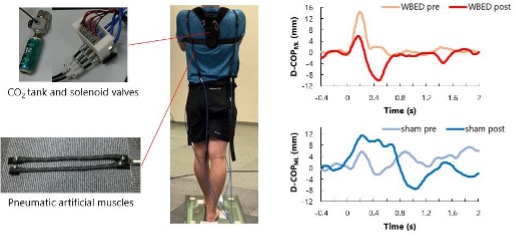Summary
Scientists develop an innovative device to help older individuals train their posture control, minimizing the risk of falls and associated injuries.
Details of the 2023 International Conference on Data Science and Engineering are listed below:
Maintaining balance and posture is quite a complex skill, even though it comes naturally to most people. However, postural control tends to worsen with age due to various reasons, such as muscle weakness coupled with changes in vision and sensory input. This explains why older people are much more prone to falling and suffering fall-related injuries than younger individuals. Approximately 40% of older individuals have been reported to fall at least once a year.
In this regard, over the past few decades, scientists have found that postural control can be improved through various exercises, which in turn helps prevent falls. It is possible to train and cultivate the ability to perform compensatory postural adjustments (CPAs) to counteract the effects of unexpected external perturbations. Although scientists have come up with specialized devices to perform balance exercises involving unexpected perturbations, these machines are generally bulky, expensive, and complex to use, rendering them suitable for clinical settings only.
But could there be a more practical way to perform these exercises comfortably at home? In a recent study published in IEEE Journal of Translational Engineering in Health and Medicine on 31 August 2023, a research team led by Assistant Professor Masataka Yamamoto from Tokyo University of Science (TUS), Japan, and including Professor Hiroshi Takemura, Mr. Daiki Yoshikawa, and Mr. Taku Washida from TUS, as well as Professor Koji Shimatani from the Prefectural University of Hiroshima, explore this question. For their research, the researchers developed an innovative wearable balance exercise device (WBED) and investigated its effects on CPAs and reactive postural control.
The proposed wearable device uses two pneumatic artificial muscles (PAMs) to generate unexpected perturbations. These PAMs, which resemble a pair of hollow shoulder straps or suspenders, can be forced to extend or contract by regulating the air pressure inside them. For this purpose, the WBED includes a set of electronically controlled valves connected to a can of compressed gas. This enables a computer program or smartphone application to control the valves and quickly fill or empty either PAM with gas, producing a force that pulls the user sideways in a specific direction.
To test whether WBED can truly improve reactive postural control, the researchers recruited 18 healthy adult males and divided them randomly into two groups: WBED and sham. All participants first underwent an evaluation of reactive balance. They had to hold a tandem stance for one minute while air cylinders on both sides of the hips pushed them laterally at unpredictable moments. The participants in the WBED group then performed a few rounds of balance training using the proposed device, while the sham group underwent the same exercises without unexpected perturbation. Lastly, a second evaluation was performed to check for improvements in postural control.
The researchers measured several variables as outcomes during the evaluations, including peak displacement, time at peak displacement, peak velocity, and root mean square of the soles’ center of pressure. Notably, participants in the WBED group exhibited lower displacement and peak velocity after exercising with the device. “Our results prove that perturbation-based balance exercises using WBED immediately improve the subjects’ reactive postural control,” remarks Dr. Yamamoto, satisfied with their findings. “Wearable exercise devices, such as the proposed WBED, could contribute to the prevention of falls and fall-related injuries.”
In the near future, the proposed device could revolutionize how people with a high tendency to fall perform balance training, especially in countries with a steadily aging population like Japan. “We designed WBED to be lightweight, portable, and easy to use both at home and in clinical settings. It weighs only 0.9 kg and takes less than three minutes to put on,” highlights Dr. Yamamoto. By training regularly with WBED, older individuals and people undergoing physical therapy can efficiently improve postural control and responsiveness, which in turn would prevent falls and improve their overall health. Notably, WBED could also be useful for athletes who want to improve their balance.
Let us hope that wearable devices become a mainstay in balance training and health care monitoring, providing a boost to the Internet of Things technology!

(Left) Pneumatic artificial muscles in the wearable device generate small disturbances. By holding a posture against these disturbances, a user can improve their reactive postural control. (Right) Plots showing how the displacement of the center of pressure of the user’s soles in the mediolateral direction (D-COPML) significantly decreased in the group that trained with the device (WBED) compared to the ‘sham’ group. An unexpected perturbation was generated at 0 seconds.
Image credit: Masataka Yamamoto from TUS Japan]
| Reference | |
| Title of original paper: | Perturbation-based Balance Exercise Using a Wearable Device to Improve Reactive Postural Control |
| Journal: | IEEE Journal of Translational Engineering in Health and Medicine |
| DOI: | 10.1109/JTEHM.2023.3310503 |
About The Tokyo University of Science
Tokyo University of Science (TUS) is a well-known and respected university, and the largest science-specialized private research university in Japan, with four campuses in central Tokyo and its suburbs and in Hokkaido. Established in 1881, the university has continually contributed to Japan’s development in science through inculcating the love for science in researchers, technicians, and educators.
With a mission of “Creating science and technology for the harmonious development of nature, human beings, and society”, TUS has undertaken a wide range of research from basic to applied science. TUS has embraced a multidisciplinary approach to research and undertaken intensive study in some of today’s most vital fields. TUS is a meritocracy where the best in science is recognized and nurtured. It is the only private university in Japan that has produced a Nobel Prize winner and the only private university in Asia to produce Nobel Prize winners within the natural sciences field.
Website: https://www.tus.ac.jp/en/mediarelations/
About Assistant Professor Masataka Yamamoto from Tokyo University of Science
Dr. Masataka Yamamoto is an Assistant Professor in the Faculty of Science and Technology, Department of Mechanical Engineering, Tokyo University of Science, Japan. His research focus includes rehabilitation, human modeling, and biomechanics in the areas of medical engineering, biomedical engineering, biomaterial science and engineering, medical systems, rehabilitation science and welfare engineering. He earned his Ph.D. from Hiroshima University Graduate School, Division of Engineering, The Department of System Cybernetics in 2018. He has served as a member of The Japan Society of Mechanical Engineers. Dr. Yamamoto has authored about 30 refereed papers and proceedings and another 52 presentations.
Funding information
This work was supported in part by the Research Grant Program of the Futaba Foundation and a grants-in-aid for scientific research by the Japan Society for the Promotion of Science (JSPS KAKENHI grant no: 22K18240).
| Media contact | Hiroshi Matsuda |
| Additional information for EurekAlert | |
| Latest Article Publication Date: | 31 August 2023 |
| Method of Research: | Experimental study |
| Subject of Research: | People |
| Conflicts of Interest Statement: | The authors declare no conflicts of interest |
Summary for EurekAlert
Falls are a serious risk for older individuals and people with compromised balance. However, there are no convenient devices to train one’s reactive posture control against unexpected perturbations outside of clinical settings. To tackle this issue, researchers from Japan have developed a lightweight wearable device to perform balance exercises at home. The experimental results showcase the potential of this device to improve postural control, thus helping prevent falls and fall-related injuries.





